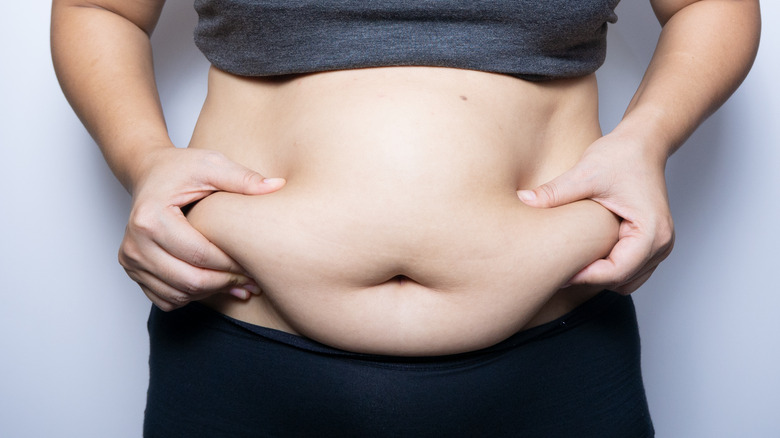What Parts Of Your Body Are More Prone To Weight Gain?
When you've found an outfit that fits perfectly in all the right places, you'll likely work hard to make sure it stays that way. It accentuates the parts you want to flaunt and hides those body areas you'd rather camouflage. However, even the tiniest bit of weight gain in your hips or arms might lead you to want to throw it out.
For many people, weight gain can be a tricky subject. Some people simply eliminate a preferred beverage from their daily routine and seem to achieve weight loss results, while others adhere to heavier restrictions and still experience unwanted weight gain.
For those trying to achieve a specific body type, understanding how and where the body is prone to gain weight can be a pivotal factor for success or failure. While a number of supplements and diet foods claim to target fat loss in a specific area, Healthline explains that there is a lack of evidence supporting the possibility of directing weight loss toward one region. However, the same isn't quite true for where the body gains weight.
Fat loss in specific areas of the body
Before you spend countless hours crafting a new diet and exercise routine to avoid gaining weight, there are a few things to consider. One of these is how and where the body holds and stores fat cells. In general, most people gain weight evenly across their bodies (via Byrdie). However, there are specific factors that can influence how weight gain is initially accumulated in the body.
Your overall health is influenced by your genetic make-up. Your fat storage, the types of fat cells that are stored, and where they are stored first or most often are also influenced heavily by genetics. Fat storage determines how weight loss and gain happen throughout the body, as explained by Healthline. More specifically, there's an order to which areas of the body shed and store excess fat cells — and the order is determined primarily by your individual genetic makeup. This is why some people can seem to gain weight without it changing the shape of their bodies and others do not (via Healthline).
Weight gain in men and women
As Glamour explains, women tend to have more ample subcutaneous fat cells in the midsection, hips, breasts, and thighs compared to men. This is what provides women with those feminine curves. LiveScience notes that women have more fat storage in their hips and thighs than men, primarily due to the need for extra energy during pregnancy and nursing. This is often referred to as sex-specific fat (via Byrdie). For women, the hips, thighs, buttocks, breasts, and belly are typically the first areas to illustrate weight gain.
For men, there's a similar storage system. However, most men tend to gain weight in their bellies before other parts of the body, according to LiveScience. This is because the belly is the primary fat storage location for men.
Paying attention to where you are gaining weight can also be an indication of your overall health. According to Men's Health, weight gain solely around the waist can be an indicator of health problems, like diabetes and heart disease. It's important to speak with your doctor about unexplained weight gain, regardless of where it occurs.



